Fact or Myth: sustainable fashion has zero environmental impact.
Unfortunately, this is a myth. Despite what some brands like to tell consumers, even sustainable fashion can leave a negative impact on the environment.
We acknowledge that there is no perfect solution. Nevertheless, we can invest in a wardrobe that substantially minimizes damage to our planet. In fact, one way to do this is by carefully crafting a sustainable closet by buying less and buying better. Here are six of our favourite tips to make your clothes last longer:

1. Handle With Care
Did you know that hand-washing your clothes prevents fading, stretching, and damaging of fabric fibers? Yet even on a “Gentle” or “Delicate” cycle, washing machines can cause agitation from different materials tumbling together. Instead of waiting for enough dirty clothes for a load, wash a few garments by hand to save on water and energy. This is better for your wardrobe, the environment, and your wallet! In fact, this will also ensure you don’t over wash; maintaining the integrity of your garments.
A tip from your friends at Public Myth: wash in cold water and air-dry to prevent wrinkling and shrinking!
2. Use Eco-Friendly Laundry Detergent
Using Eco-friendly laundry detergent is better for the Earth and your clothes. Standard detergents aren’t biodegradable and contain harsh chemicals called “phosphates” that contaminate our water supplies. Additionally, these toxins also have an impact on the lifespan of our garments. By switching to an environmentally-friendly laundry detergent, you can ensure that the lifespan of your wardrobe is a long one.
What should you look for in an Eco-detergent? Keep an eye out for words like phosphate and surfactant-free, biodegradable, natural fragrance, and not tested on animals.
3. Fold, Don’t Hang
Putting your clothes on a hanger may be aesthetically-pleasing, but it can cause irreversible stretching over time. Folding your clothes and placing them on a shelf can prevent the thinning of fabrics, especially in the shoulders of your garments. Say goodbye to loose threads!
Bonus: Lavender or cedar is an all-natural alternative to mothballs, which can also be used to preserve your fabrics.
4. Upcycle Your Sustainable Fashion
If you’re looking to pick up a new skill– let it be this one! Learning to mend your clothes can help you from having to discard your favourite pieces. You no longer have to fear a small imperfection like a small rip, loose stitch, or missing button. There are plenty of free online resources to learn how to patch up minor fixes. Keep your clothes wearable for longer, and out of landfills.

5. Look Out For Eco-Friendly Fabrics
Did you know the fashion industry used to produce four collections a year, one for every season? Nowadays, labels are churning out 52 micro-collections a year! The goal of a fast-fashion company is to keep up with demand, and produce as many collections for the lowest possible cost. The only way to do this is to pump out garments that are hastily made with cheap, low-quality fabrics. This is to keep prices low, but also to encourage repeat purchases from their customers. By investing in high-quality materials, you’ll not only be saving yourself money in the long run, but reducing pollution and environmental impact.
Not to mention, putting synthetic fibers like nylon and polyester through the wash releases billions of micro-plastics. These micro-plastics are difficult to filter and eventually find their way into our oceans and aquatic life. You can reduce plastic pollution by investing in Eco-friendly fabrics like bamboo, organic cotton, and merino wool.
For more information on environmental fabrics, you can check out our fabrics page, here.
6. Sustainable Fashion: Quality Over Quantity
Buy less, buy better. The price of sustainable fashion may seem daunting at first. The truth is, fast fashion is more costly to your wallet and the environment in the long run. It’s important to invest in quality pieces that can be worn for many years to come. Here are Public Myth’s Golden Tips for curating your conscious closet:
- Invest in versatile pieces that can be styled many different ways.
- Try to steer clear of fast-fashion trends that will be out of season next year (we know it’s tempting!)
- Invest in high-quality, eco-friendly fabrics that are durable and designed to last.
Final Thoughts:
In conclusion, fashion doesn’t have to be fast. With these six tips, your wardrobe can last beyond your wildest expectations.
For more on affordable and ethical fashion, check out our previous blog here.

Leave a Reply